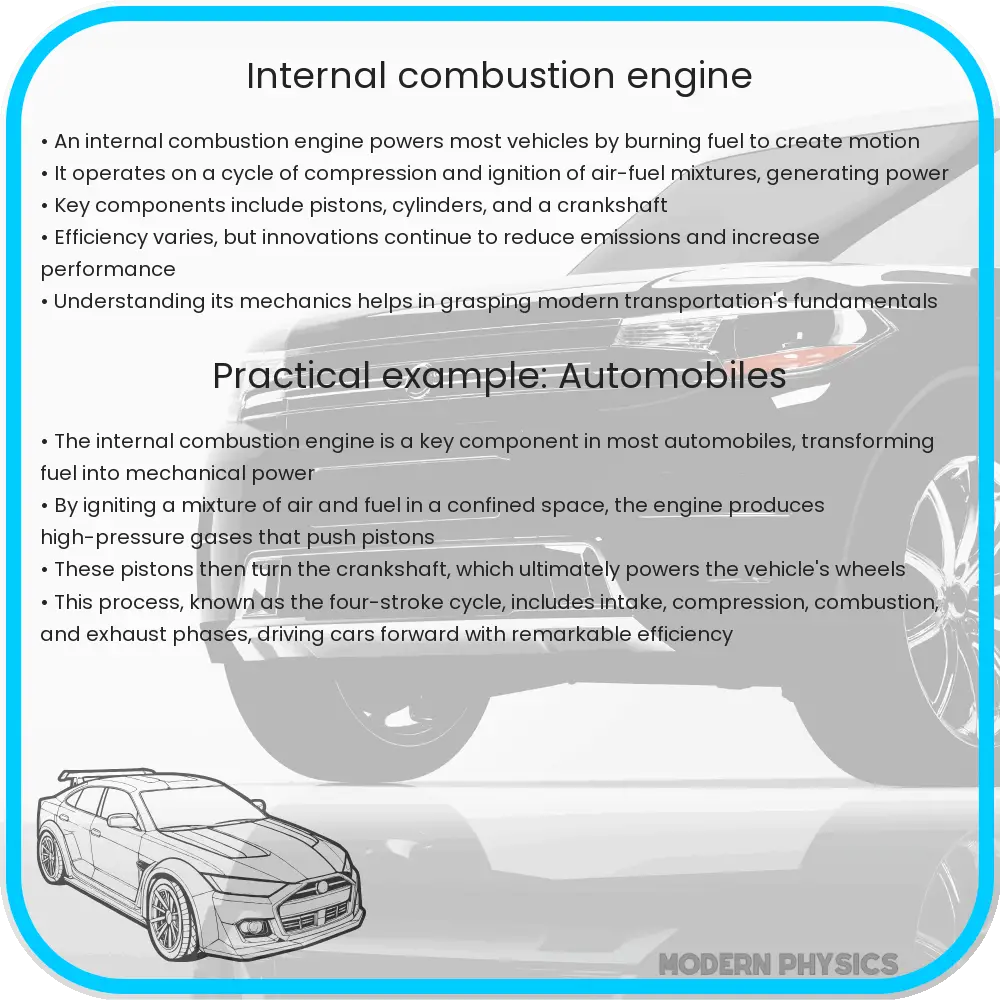Explore the mechanics, efficiency, and future of internal combustion engines, and their role in modern transportation and environmental impact.

Understanding the Internal Combustion Engine: Dynamics, Efficiency, and Power
The internal combustion engine (ICE) is a marvel of engineering that powers most of the world’s vehicles. Its operation is based on the fundamental principles of thermodynamics and mechanical engineering. This article delves into the dynamics, efficiency, and power output of ICEs, providing an insightful understanding of how these engines work and their impact on modern transportation.
The Dynamics of Internal Combustion Engines
At its core, an internal combustion engine is a complex assembly where fuel and air are mixed and burned to create energy. This process involves several steps: intake, compression, combustion, and exhaust. Each phase plays a crucial role in the engine’s operation. During the intake phase, the engine draws in air and mixes it with fuel. The mixture is then compressed in the combustion chamber, significantly increasing its temperature and pressure. This sets the stage for the combustion phase, where a spark ignites the mixture, causing an explosion that drives the piston downwards. This movement is transformed into rotational motion, powering the vehicle. Finally, the exhaust phase expels the used gases, making room for a fresh mixture of air and fuel.
Efficiency of Internal Combustion Engines
The efficiency of an ICE is a measure of how well it converts the energy in fuel into mechanical work. Unfortunately, no engine is 100% efficient due to inherent energy losses in the form of heat, sound, and friction. The thermal efficiency of a typical gasoline engine is around 25-30%, meaning only a quarter to a third of the fuel’s energy is used for propulsion; the rest is lost. Engineers continually strive to improve this efficiency through advanced materials, design, and technologies like turbocharging and direct fuel injection.
Power Output in Internal Combustion Engines
Power output in ICEs is influenced by several factors, including engine size, number of cylinders, and the efficiency of the air and fuel mixture. Larger engines generally produce more power but at the cost of increased fuel consumption and emissions. The power output is also impacted by the engine’s RPM (revolutions per minute), with higher RPMs typically delivering more power.
In conclusion, understanding the dynamics, efficiency, and power of internal combustion engines is crucial for appreciating the engineering behind most of today’s vehicles. While they are not without their environmental impacts, ongoing innovations continue to enhance their performance and reduce their ecological footprint.
Innovations and Future of Internal Combustion Engines
As we progress further into the 21st century, the internal combustion engine continues to evolve. Innovations in materials and technology have led to more efficient, powerful, and environmentally friendly engines. The use of lightweight materials like aluminum and carbon fiber reduces the overall weight of the engine, enhancing efficiency and performance. Additionally, the integration of computer-controlled systems has revolutionized engine management, optimizing fuel delivery, ignition timing, and emission control.
Environmental Impact and Alternatives
Despite these advancements, the environmental impact of ICEs remains a significant concern. The combustion process releases carbon dioxide (CO2), a greenhouse gas, contributing to global climate change. Furthermore, engines emit pollutants like nitrogen oxides (NOx) and particulate matter, which affect air quality and public health. In response, there is a growing shift towards alternative propulsion systems such as electric vehicles (EVs) and hybrid technologies. These alternatives offer the potential for reduced emissions and a move towards sustainable transportation.
Challenges and Future Outlook
While electric and hybrid vehicles are gaining popularity, there are still challenges to overcome, such as battery technology, charging infrastructure, and range limitations. In the meantime, ICEs continue to be improved to meet stricter emission standards and to become more fuel-efficient. Research into renewable fuels like biofuels and hydrogen also presents opportunities for making ICEs more sustainable. The future of transportation is likely to be a diverse mix of technologies, with internal combustion engines playing a significant but evolving role.
Conclusion
The internal combustion engine has been a cornerstone of automotive technology for over a century. Its development reflects a journey of constant innovation and adaptation. While its environmental impact cannot be overlooked, ongoing advancements in efficiency, emissions control, and alternative fuels are paving the way for a more sustainable future. The balance between traditional ICEs and emerging technologies like electric and hybrid vehicles will define the next chapter in the story of transportation. Understanding the complexities and potential of ICEs is key to appreciating their role in this dynamic landscape and their contribution to modern society.
